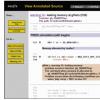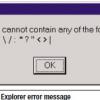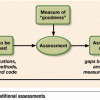|
|
Applying Testing Expertise to the Retrospective Goldmine Digging up postmortem project data is like mining for gold. The returns can be significant and long-term because this is where your best (and worst) practices really shine. By allowing your test groups to drive the retrospective activities, improvements can finally be built into the product lifecycle model instead of rotting in a postmortem report. By improving retrospective facilitation and follow-up, you'll ultimately improve your software lifecycle process. Nick Borelli delivers a practical and proven approach to the retrospective process, and shows you how to build consensus for process improvements uncovered during retrospective analysis.
|
Nick Borelli, Microsoft Corporation
|
|
|
Software Documentation Superstitions Do you need credible evidence that disciplined document reviews (a.k.a. inspections) can keep total project costs down while helping you meet the schedule and improve quality? The project documentation we actually need should meet predetermined quality criteria, but organizations are often superstitious about writing this documentation-and they let their superstitions inhibit their efforts. This presentation dispels the superstitions and shows you how reinforcements for improving the quality of your software project documentation-such as requirements, design, and test plans/procedures-can occur through disciplined document reviews.
|
Gregory Daich, Software Technology Support Center
|
|
|
Software Inspection: A Failure Story? Even the most successful inspections can fail if team members aren't vigilant. A large financial institution has agreed to allow their story to be told (anonymously) for the purpose of illustrating how a program that was a classic success could fall into disuse. Specifically, you'll see how the company built up a very successful inspection program, and was achieving significant benefits, until four years later when inspections were no longer being done. How did this happen? Is it unique? What did they do right, and in the end what went wrong? This presentation delivers the lessons learned from this story, so you can avoid making the same mistakes.
|
Dorothy Graham, Grove Consultants
|
|
|
The Guided Inspection Technique Early detection of faults is a cost-effective technique for ensuring quality. The guided inspection technique described in this presentation uses explicit test cases to guide the inspection process rather than leaving the coverage of the model to chance. Learn how this technique systematically determines whether the model is complete, correct, and consistent. Gain an understanding of how to integrate this technique into the typical, iterative, incremental process.
|
Melissa Russ, Korson-McGregor
|
 |
A Look at PREfix by Intrinsa PREfix provides a source code simulation tool that is able to perform automatic review for a wide range of programming defects that lead to program crashes. Defects reported by PREfix include de-referencing NULL pointers, using uninitialized memory, leaking memory or resources, or using illegal values. Here is an analysis of the product.
|
|
 |
The Two Bugs Brian Marick applies the philosophical concept of "ready-to-hand" to software programming and describes two bugs that illustrate problems caused by mismatched reuse of ideas.
|
|
|
|
Why Testers Should Participate in Early Reviews Do testers really belong in early reviews? For Michael Dedolph, the answer is yes! For that matter, he thinks more installers should be involved as well. Why? Testers and installers are usually involved in the "end game," so they add value by bringing that very different point of view to the review process.
|
|
 |
When Assessments Are Relative Taking development and business contexts into consideration can mean the difference between a correct assessment and a useful assessment. Here's information on how to provide an assessment that's both correct and effective.
|
|
|
|
Software Code Inspection for Defect Prevention Thousands of hours are spent testing, but most software professionals find that traditional testing simply isn't enough to ensure code quality. This presentation gives software professionals a complementary approach: software inspection. Learn how software inspection differs from traditional testing, and gain an understanding of principal inspection techniques.
|
Jasper Kamperman, Reasoning
|
|
|
How to Break Out of the Same Old Routine with Retrospectives How many times have you finished testing on a release and said "Boy, I never want to go through one like that again." Or have you ever had a project canceled and said "If only I would have known at the beginning, what I know now, I would have done things a lot differently." Or when you finished testing on release one, said “next time I want to do it differently,” then said the same thing on releases two, three, and four? If any of these thoughts resonate with you, then I think you will be interested in the Lessons Learned process. Lessons Learned is a powerful post-mortem process that can be used at the end of a project, phase, or deliverable to evaluate how things went, and what could be improved.
|
Randy Slade, Kaiser Permanente Information Technology
|

